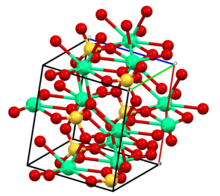
Back كبريتات الكالسيوم Arabic Kalsium sulfat Azerbaijani کلسیوم سولفات AZB ক্যালসিয়াম সালফেট Bengali/Bangla Sulfat de calci Catalan Síran vápenatý Czech Calciumsulfat Danish Calciumsulfat German Sulfato de calcio Spanish کلسیم سولفات Persian

| |

| |
| Names | |
|---|---|
| Other names | |
| Identifiers | |
| |
3D model (JSmol)
|
|
| ChEBI |
|
| ChEMBL | |
| ChemSpider | |
| DrugBank | |
| ECHA InfoCard | 100.029.000 |
| EC Number |
|
| E number | E516 (acidity regulators, ...) |
| 7487 | |
| KEGG | |
PubChem CID
|
|
| RTECS number |
|
| UNII |
|
CompTox Dashboard (EPA)
|
|
| |
| |
| Properties | |
| CaSO4 | |
| Molar mass | 136.14 g/mol (anhydrous) 145.15 g/mol (hemihydrate) 172.172 g/mol (dihydrate) |
| Appearance | white solid |
| Odor | odorless |
| Density | 2.96 g/cm3 (anhydrous) 2.32 g/cm3 (dihydrate) |
| Melting point | 1,460 °C (2,660 °F; 1,730 K) (anhydrous) |
| 0.26 g/100ml at 25 °C (dihydrate)[1] | |
Solubility product (Ksp)
|
4.93 × 10−5 mol2L−2 (anhydrous) 3.14 × 10−5 (dihydrate) [2] |
| Solubility in glycerol | slightly soluble (dihydrate) |
| Acidity (pKa) | 10.4 (anhydrous) 7.3 (dihydrate) |
| -49.7·10−6 cm3/mol | |
| Structure | |
| orthorhombic | |
| Thermochemistry | |
Std molar
entropy (S⦵298) |
107 J·mol−1·K−1 [3] |
Std enthalpy of
formation (ΔfH⦵298) |
-1433 kJ/mol[3] |
| Hazards | |
| NFPA 704 (fire diamond) | |
| Flash point | Non-flammable |
| NIOSH (US health exposure limits): | |
PEL (Permissible)
|
TWA 15 mg/m3 (total) TWA 5 mg/m3 (resp) [for anhydrous form only][4] |
REL (Recommended)
|
TWA 10 mg/m3 (total) TWA 5 mg/m3 (resp) [anhydrous only][4] |
IDLH (Immediate danger)
|
N.D.[4] |
| Safety data sheet (SDS) | ICSC 1589 |
| Related compounds | |
Other cations
|
Magnesium sulfate Strontium sulfate Barium sulfate |
Related desiccants
|
Calcium chloride Magnesium sulfate |
Related compounds
|
Plaster of Paris Gypsum |
Except where otherwise noted, data are given for materials in their standard state (at 25 °C [77 °F], 100 kPa).
| |
Calcium sulfate (or calcium sulphate) is the inorganic compound with the formula CaSO4 and related hydrates. In the form of γ-anhydrite (the anhydrous form), it is used as a desiccant. One particular hydrate is better known as plaster of Paris, and another occurs naturally as the mineral gypsum. It has many uses in industry. All forms are white solids that are poorly soluble in water.[5] Calcium sulfate causes permanent hardness in water.
- ^ Lebedev, A. L.; Kosorukov, V. L. (2017). "Gypsum Solubility in Water at 25°C" (PDF). Geochemistry International. 55 (2): 171–177. doi:10.1134/S0016702917010062. S2CID 132916752.
- ^ D.R. Linde (ed.) "CRC Handbook of Chemistry and Physics", 83rd Edition, CRC Press, 2002
- ^ a b Zumdahl, Steven S. (2009). Chemical Principles 6th Ed. Houghton Mifflin Company. p. A21. ISBN 978-0-618-94690-7.
- ^ a b c NIOSH Pocket Guide to Chemical Hazards. "#0095". National Institute for Occupational Safety and Health (NIOSH).
- ^ Franz Wirsching "Calcium Sulfate" in Ullmann's Encyclopedia of Industrial Chemistry, 2012 Wiley-VCH, Weinheim. doi:10.1002/14356007.a04_555
© MMXXIII Rich X Search. We shall prevail. All rights reserved. Rich X Search
